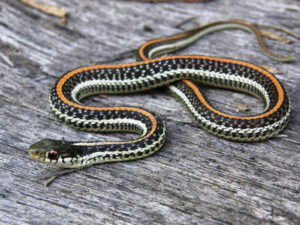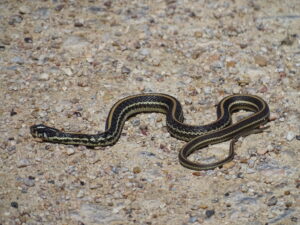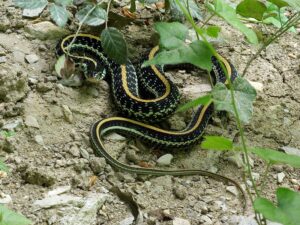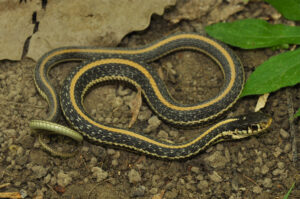Texas Garter Snake (Thamnophis sirtalis annectens)
Updated on
25/04/2024The Texas garter snake is a subspecies of the common garter snake and is endemic to the western United States. The solitary, diurnal snake is terrestrial in nature. It helps control pest populations in gardens, residential areas, and greenhouses. This is why it is also known by the common name garden snake.
Scientific Classifications
- Suborder:Serpentes
- Family:Colubridae
- Genus:Thamnophis
- Species:T. sirtalis
- Subspecies:T. s. annectens
Conservation Status
Description
Size
The total length of an adult, including the tail, is 15-28 in (38-71 cm).
Color and Appearance
The Texas garter snake has a greenish-black dorsum with a distinct red or bright orange stripe running down its center. There are yellowish stripes on either side of the body that spread across the 2nd, 3rd and 4th dorsal scale rows above the belly plates.
Are They Dangerous to Humans
The colubrid is generally non-aggressive though the younger snakes strike when cornered. Their mild venom is enough to subdue their prey but is harmless to humans. The bite can only produce temporary swelling and slight irritation in them. When handled, these snakes often flail about wildly, attempting to escape and release foul-smelling musk from their cloaca.
Texas Garter Snakes at a Glance
Distribution
This garter snake is mainly found in central Texas. There are disjoined populations in western Oklahoma and southwestern Kansas. But it is uncommon even in its range and rarely found in large numbers.
Habitat
It lives in a wide variety of habitats that have one thing in common. They are all located near a water source. It typically inhabits stream-side vegetation or damp soil near water bodies. It can also be found under objects like wood or old metal, in plants, and underground.
Lifespan
The Texas garter snake has a lifespan of 2-10 years.
Predators
The serpent is preyed upon by hawks, raccoons, foxes, herons, and other snakes.
Diet
The ambush predators eat earthworms, snails, amphibians, and insects. As they don’t have fangs, they can’t inject venom. Instead, its toxic saliva enters the prey’s bloodstream through the bite wound.
Reproduction
Ovoviviparous (gives birth to live young from eggs that hatch inside the body)
20-40 live young form a litter. They are fully independent from birth and can fend for themselves. They become sexually mature at 1.5-2 years of age.
Source
digital.sfasu.edu, inaturalist.org, dfwurbanwildlife.com, eol.org









